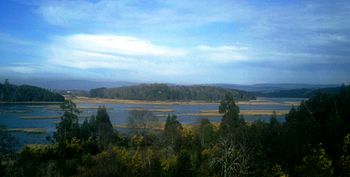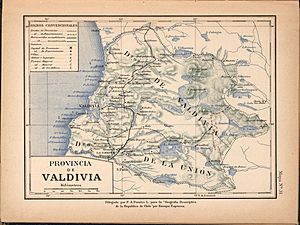Cruces River facts for kids
Quick facts for kids Cruces River |
|
|---|---|

|
|

Cruces River on a map of 1903
|
|
| Country | Chile |
| Physical characteristics | |
| Main source | Hills north of Calafquén Lake, near Villarrica Volcano |
| River mouth | Valdivia River |
| Length | 125 km (78 mi) |
| Basin features | |
| Basin size | 3,233 km2 (1,248 sq mi) |
The Cruces River (which means Río Cruces in Spanish) is an important river in south-central Chile. It starts in the hills near the Villarrica volcano. The river then flows towards the southwest. Near the city of Valdivia, the Cruces River joins the Valdivia River. A bridge called Río Cruces Bridge crosses it there.
Contents
How the River Changed
The Big Earthquake of 1960
In 1960, a very powerful earthquake hit the area near Valdivia. This earthquake caused the land to sink by about 2 meters (6.5 feet). Because of this, a large area of fields and pastures around the lower part of the Cruces River became permanently flooded.
New Wetlands and Wildlife
Over time, these new flooded areas turned into wetlands. Many water plants, especially one called Egeria densa (also known as luchecillo), started to grow there. These plants created a rich aquatic ecosystem, which is like an underwater neighborhood for animals. This new habitat attracted many birds. A special bird, the black-necked swan, became very common in these wetlands. To protect this important natural area, the Carlos Anwandter Nature Sanctuary was created in 1981.
Protecting the Swans
In 2004, a new factory called the Valdivia Pulp Mill opened nearby. Around the same time, the number of black-necked swans in the Cruces River wetlands dropped sharply. About 96% of the swans either died or moved away in just six months. People in Valdivia were very worried about this. They believed the factory was causing pollution that harmed the swans and their food, the Egeria densa plants. This led to a big disagreement between the local people and the company that owned the factory.
River Water and the Future
Saltwater Concerns
A study in 2020 looked at the water levels in the Cruces River and another river nearby, the Calle-Calle River. It found that if the total amount of water flowing in these rivers drops too low, saltwater from the ocean can reach Valdivia's drinking water supply. This usually happens in the autumn.
Climate Change Effects
Scientists expect these low water levels to happen more often in the future. This is because of Climate change, which is causing less rainfall in the area. This means it's important to manage the river's water carefully to make sure there's enough fresh water for everyone.
Riverbank Soils
The land around the lower part of the Cruces River has special types of soil. These soils are called trumaos and red clay soils.
Gallery
See also
 In Spanish: Río Cruces para niños
In Spanish: Río Cruces para niños



